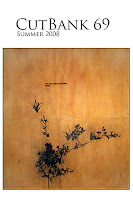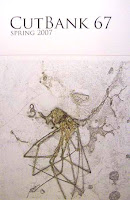
New Directions, 2010
192 pp, $29.95
New York, NY
http://www.ndpublishing.com/
A three inch deep box that opens like a bivalve or casket houses Carson’s book, Nox; the book inside is not bound to a backing but folded, concertina-style, and piled on itself. The one hundred and ninety-two unpaginated pages reproduce a note-and-scrap book containing lexigraphic entries, family photographs, collage, paintings and sketches, excerpts, quotations, and numbered autobiographical notes. Both the cover of the box and top page display on gray background a section of a photographic image of Carson’s brother as a boy, in flippers and goggles. The enigma of his character and death comprise the impetus and premises of Carson’s project, a project she describes as an epitaph.
Within the first few pages the reader is met with a blurred photocopy of a Catullus’ elegy for his brother in its original Latin. What follows, on almost every left-facing page, but a dictionary entry for each successive word in the poem, listing the relevant English meanings and a few carefully composed examples. Below is the entry for nequiquam:
nequiquam adverb
[NE + quiquam] to no purpose or effect, vainly, without avail; et sero et niquiquam pudet late and pointlessly she blushes; (in litototes) without cause, groundlessly; (dubious) by no means; (as an exclamation) nequiquam! For naught! (why?)
On the other pages, all variety of personal trivia and notation narrate piecemeal the life and death of her brother, Michael.
The reader learns where (Copenhagen) and when (2000) he died, that his death was unexpected, and that news of it took two weeks to reach Carson. The reader also finds out where the funeral was held and how his widow spoke and behaved there and disposed of his ashes, how his dog reacted. The reader obtains knowledge of his involvement with drugs, his running-away and name change, his several wives and lifestyle abroad; they learn of the frequency and contents of his correspondence and nature of relations with his sister and mother, as well as how he spoke and behaved as a child, and that his eyes were blue. There are facts concerning the subject, such as the cause of death, that a reader does not receive, but it is unclear whether Carson is withholding them or knows no more herself.
Often described as a ‘highly acclaimed classicist and poet’, or ‘scholar and artist’, Carson has been lauded, dismissed, and cited for her generic positioning, her confessional content, her archival yet abstract, clinical yet intimate methodologies. A reader of her other books expects a sensitivity in presentation to the material and historic nature of words, as well as auto-biographical statements made in a voice which combines ironic, pedgagic, and lyric tones. Nox displays tactics and values present in much of Carson’s other writing: it doesn’t merely play at, but insists both on being experienced as history, and as an intensely personal artifact.
In a review for the New York Times, Sam Anderson describes Nox as a ‘deeply moving…brilliantly-curated scrap heap’, an ‘elegy and meta-elegy’; he finds in it the simultaneous portrait of a specific brother and a kind of Everybrother, noting the suspense that builds around the disclosure of this person’s details. Megan O’Rourke, writing for The New Yorker, also found Nox “personal and deeply moving”, stating that “despite its inclusion of personal details, [Nox is] as much an attempt to make sense of the human impulse to mourn.” Ben Ratliff calls it “precious in the best sense of the word” (NYT Sunday Book Review), and Michael Dirda finds it ‘moving yet strikingly unconventional’ (Washington Post). Only Dirda cautions readers against the fallacy of ascribing biographical truth to the book’s contents. In the Philadelphia Inquirer, John Timpane addresses directly this issue circumscribed by other reviews, claiming that Nox is not precious because of its ’‘painful, authentic uneasiness with itself…it’s self-consciousness and irony.”
“Why do we blush before death?” Carson’s invocation of this visceral and cosmetic change of color---one of performance as well as true feeling---gives the reader a sense of this self-consciousness. “If you are writing an elegy begin with the blush.” A few other aspects of Nox gesture towards the dual nature of elegy. The book, as object, is unwieldy; the shoring together of different forms and sources puts the syllogistic momentum out of joint; it frequently points to its own limitations and failures (“no use expecting a flood of light”).
More often, though, the work encourages illusions of transparency and genuineness. It is, after all, a photocopy of a notebook. In addition to imparting the material for a story of her brother, his death, and her grief, Carson directly addresses the reader (“I want to explain about the Catullus poem (101)”); she tells them what her brother called her as a girl (‘pinhead’, ‘professor’); she may even slip an elegy for herself into the definition of cinerum (“this ash was a scholarly girl”). At moments, she implies the validity of her endeavor by universalizing: “All the years and time that had passed over him came streaming into me, all that history. What is a voice?” It is not by accident that one finds the most striking language and thought in the sources mined---in dry definitions and ceremonial, restrained phrases of poets and historians who never prick the surface tension of their grief with disclosure, who point beyond themselves, always, to something else.
This Night situates itself as coffer and gift—but to who is unclear, as it is known that books cannot be enjoyed by the dead. Perhaps its universalisms and tropes of authenticity redeem the book from a certain kind of preciousness. If not, its quiet self-consciousness, generic quirks, and ironies challenge a simple categorization. But these too could be identified as related and not unproblematic methods: secret telling and its loopholes of explanation and wit, generalization, complicity, and voyeurism---does one not have boxes enough, secrets enough, of one’s own? If not, why conflate them with another’s? The shuttle of embarrassment, the loom of gossip and guesswork, the fabric of coy exposure: these discomforts combine with the pleasures of reading Nox to make up a mixed, complex encounter.
- - -

- - -
Andrea Applebee recently completed her MFA at the University of Pittsburgh. She presently lives in Philadelphia, where she teaches composition.



